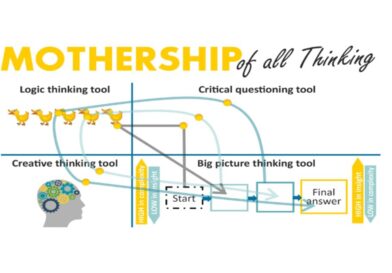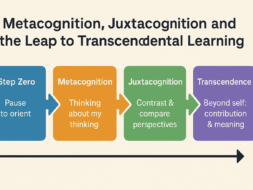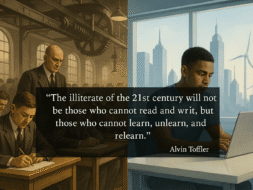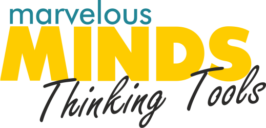What does ChatGPT say about the Fourth Education Revolusion and the Mothership of all Thinking?
Universally there is an undeniable need for a profound change in the teaching and learning landscape. Such a change has already been developed and is successfully being implemented in South Africa, where the teaching footprint of the Thinking Tools team is expanding by enrolling school and tertiary students, as well as teachers, in Thinking Tools study technique courses. Based on the current curriculum and standardized assessments, there is consistent evidence that students are spending less time (rote) learning while their marks are improving, their vocabulary is expanding, and their willingness to take risks is increasing. Teachers using Thinking Tools require less preparation time while gaining deeper insights into the subjects they teach.
The secret to the solution lies in the interplay between the industrial revolutions, the subsequent education revolutions, and the brain's wiring for learning.
The First Education Revolution (early to late 19th century) evolved after the First Industrial Revolution (late 18th to early 19th century), which was known for the shift from agrarian endeavors to industries. This necessitated basic literacy and numeracy skills, leading to the establishment of structured school systems where teachers were the central figures in classrooms imparting their curricula through direct instruction to their students. This teacher-based learning was effective for its time.
During the Second Education Revolution (early to late 20th century), which followed the Second Industrial Revolution (late 19th to early 20th century), the focus shifted to standardized curricula that ensured consistency in what was taught across different schools, underwriting a "one-size-fits-all" approach to establish workforces with sets of common values, skills and knowledge. This was the beginning of content-based teaching and learning, which is still deeply entrenched in the education system's DNA.
During the Third Education Revolution (early 21st century), which followed the Third Industrial Revolution (late 20th century), the education landscape was expanded by adding standardized assessment systems on top of the curricula to objectively measure student achievement. This introduced a layer of accountability to address standardization aimed at global competitiveness.
This constituted a content-based teaching and summative assessment-driven education system that frequently resulted in teaching to the test, thereby stifling creativity and individual learning paths.
The brain-based Fourth Education Revolution needed for the Fourth Industrial Revolution (early 21st century) does not yet exist in full because education systems remain entangled in the strong teaching, learning, and assessment legacies of the Third Education Revolution. Rote learning, memorization, and standardized summative assessments are still alive and well, but they are insufficient for preparing students to tackle the complex challenges of the 21st century.
The transition from the 3ER to the 4ER requires a fundamental shift in both pedagogical approaches and assessment methods. It is not sufficient to merely modify existing 3ER strategies; instead, a complete overhaul is necessary to meet the demands of the 4ER. There are movements that remain entrenched in the 3ER paradigm, using mind maps in isolation rather than adopting a holistic and integrated brain-based approach. This narrow focus limits innovative critical thinking.
Similarly, other movements are caught up in the 3ER assessment paradigms, conducting assessment tests on students to determine to which extent the learning could have instilled critical thinking. This leaves them with results they are not able to take care of in the absence of a 4ER approach to teaching and learning.
To truly embrace the 4ER, educators must move beyond these half measures and adopt methods that cultivate lateral thinkers, innovators, and leaders from Generation Z and beyond. These students, shaped by the rapid technological advancements and global interconnectedness of the Third and Fourth Industrial Revolutions, requires an education system that enables them to break free from silo thinking, where mastering knowledge is not the end but a means to an end and where knowledge can be applied in transformative ways.
Generation Z is a means-to-an-end generation who excel when they are challenged with a combination of interactive content, collaborative environments and hands-on experiences relevant to real-world situations. They flourish on immediate feedback, short-term achievements and incidental learning, all set against a backdrop of social interactions, online forums and collaborative projects.
The Thinking Tools team discovered the existence of the brain’s executive function that by default takes care of solving problems. We coined the concept as the 'Mothership of All Thinking'. When the brain takes ownership of a problem, the Mothership of All Thinking starts scanning the brain for files containing prior knowledge that can be used as a springboard for further contemplation. There are also supportive sets of inborn thinking apps that function as technological gadgets and software that the Mothership of All Thinking employs to source inputs and release when their tasks are fulfilled. Our emphasis shifted from the brain's holding capacity to its executive function, which operates like an air traffic control system, managing and coordinating the flow of numerous thoughts and ideas.
There are supportive thinking apps for dealing with facts, step-by-step thinking, comparing and contrasting, analogy thinking, cause-and-effect relations, fault finding, alternative thinking, emotional contributions, moral-ethical guidance, relational and evaluative thinking, categorizing and organizing, and analyzing and synthesizing information.
These diverse sets of thinking tools collectively contribute to creating innovative solutions, generating new knowledge and providing valuable insights, all of which are reflected in the outcomes or solutions. Once teachers and their students are educated on the brain's wiring and the function of each thinking app, students can enter the realm of self-regulated learning. In this state, they can effectively manage their own thinking processes, set goals, monitor progress, and adjust strategies to achieve academic success. As a bonus, this coincides with what is needed to succeed in the world after studies.
This visual presentation illustrates how the Mothership of All Thinking functions as the brain's executive functioning center, working holistically with critical thinking tools, logical reasoning and creative thinking to coordinate and enhance cognitive processes.
The incomplete status of the bigger-picture thinking tool prompts the critical questioning tool to generate a series of questions. This, by default, prompts the logical thinking tool to construct a series of answers. If an answer does not contribute to expanding the initial bigger picture, communication occurs between the bigger-picture tool and the logical thinking tool. The question is then referred back to the critical questioning tool, which checks it to determine whether to scrap, park, or change it, or to formulate another question. This iterative process aims to engineer a more appropriate question, which is then sent to the logical thinking tool to generate a more fitting answer. This allows the bigger-picture thinking tool to eventually achieve a solution, creating a foundation for further research. This is a slow-motion description of what sometimes happens fast and in other instances it might take hours, days, or even longer for the brain to fully develop and refine a new idea. The creative thinking tools tends to operate extremely fast resulting in an instantaneous AHA!
The solutions created by the brain are invisible and must be engineered into visual formats, similar to how an engineer or architect draws plans that reflect the extensive thinking behind them. These plans serve as evidence of planning, designing, self-testing, iteration, logical reasoning, systems thinking, resilience, collaborative thinking, ethical considerations as well as design processes. The transformation into visual representations is a supplementary learning journey that generates more new insights, as any engineer or architect will attest. In short, these visual presentations become the embodiment of applied thinking within the 4ER framework, showing how cognitive processes are transformed into tangible, real-world solutions.
As thinking processes flow and evolve through the Mothership of All Thinking in iterative ways, they create algorithms to establish best practices and avoid pitfalls. These learning algorithms are cemented as neural pathways, often becoming so firmly established that they are impossible to forget. In mathematics, such algorithms represent the discovery of methods and formulas that move beyond traditional teaching approaches, where teachers provide methods, recipes, and formulas for students to mimic in solving similar problems. The quality and quantity of these self-developed algorithms distinguish outliers from masters, experts, proficient and competent individuals, as well as beginners and novices.
The human brain, with its unparalleled ability to recognize patterns, solve complex problems and adapt to new information, plays a crucial and compatibility role in the AI setting. Just as AI systems learn and evolve through additional data and algorithms, the human brain continuously processes and integrates vast amounts of information, demonstrating a sophisticated form of natural intelligence that informs and enhances artificial intelligence development. This symbiotic relationship between human cognition and AI underscores the importance of advanced thinking skills in driving technological progress and innovation.
Shocking as it may sound, the curriculum of the 4ER is contentless, which is not difficult to motivate within the Fourth Education Revolution ecosystem. Contentless learning starts with either a commissioned instruction or as an own problem created by curiosity that must be solved. The mind's innate thinking tools pave the way for the concept of flipped teaching, which was coined by the Thinking Tools team alongside others such as ‘inner speech’, ‘auditory-blind’, ‘visually-deaf’, and ‘thinking currency’.
Flipped teaching is not the same as the flipped classroom, which aims to rejuvenate content-based teaching and learning. In flipped classrooms, discussing pre-learned knowledge gives the illusion of innovative thinking, but merely perpetuates content-based learning. It creates a dependency algorithm stating that a content stimulus is needed before innovative thinking can occur. This stifles true innovative thinking.
In flipped teaching, the role of the teacher is transformed from a source of information to a facilitator of discovery and creation. Students are empowered to delve into contextually related resources, constructing their own understanding and generating new knowledge. This enables them to actively engage with the material, changing their traditional receptive role to those who are taking the lead by doing the teaching in the class, which giving them a sense of ownership and intrinsic motivation. The teacher becomes a moderator of thinking processes and a guide on the side who provides thinking scaffolds to students who reached their zone of proximal development (as postulated by Vygotsky), enabling them to reach their full potential. This sets a scenario where students are allowed to make mistakes during their learning instead of during their final assessment. This turns the focus to assessment methods that can capture the complexity and depth of students’ innovative thinking processes and application.
This highlights the critical need to transition from summative to formative assessment approaches in education. Summative assessments, such as standardized tests or final projects, typically emphasize specific learning outcomes and occur at the end of a period of learning. Consequently, students’ learning journeys then are abruptly throttled to an end as this approach yields results that are considered as past events (water under the bridge), thereby restricting students' opportunities to improve their thinking which are crucial for critical thinking and fostering innovation. Unlike content-based summative assessments, formative assessments are student-centered and designed to support continuous improvement.
Formative assessments provide ongoing feedback and opportunities for students to revise and improve their understanding throughout the learning process. This shift is crucial as it supports the brain's natural ability to construct and refine ideas over time, rather than solely evaluating the final product, hereby encourages a dynamic and supportive learning environment where students can actively engage in iterative improvement and deeper understanding. This enables students to actively engage in self- and peer assessment, reflecting on their own and others' performances, identifying areas for improvement, and cultivating a growth mindset. This helps students to view assessments as opportunities for growth rather than judgments of their abilities, empowering them to take ownership of their learning processes.
Formative assessments consider a broader range of skills beyond academic knowledge, including critical thinking, collaboration, communication, and emotional intelligence. This holistic approach ensures a more rounded evaluation of student capabilities, providing continuous data on student performance which is facilitated by Fourth Industrial Revolution technologies that provide tools for real-time feedback and tracking students' progress. This continuous-flow-data-driven feedback helps teachers adjust their teaching strategies to better meet the needs of students and improve learning outcomes ensuring that each student receives the necessary support to succeed.
Instead of re-engineering 3ER practices that are based on 1ER and 2ER practices, the 4ER approach requires a blank-slate paradigm. The science applied in 4ER learning is the science embedded in the brain's natural wiring which we utilize in our everyday lives, from planning birthday parties to buying a new home. Beginning with simple ideas, we end up with well-organized events or major life decisions, using the brain's innate ability to create, organize and manage complex concepts effectively.
For the past 15 years, the Thinking Tools team has been researching how the brain is wired for thinking and learning. Our research enables us to empower students to tackle complex challenges across various fields, transforming them into knowledge creators and innovative thinkers capable of shaping the future, rather than being knowledge consumers.
To truly embrace the Fourth Education Revolution (4ER), we must transform our educational practices to align with the brain's natural learning processes. The Thinking Tools approach offers a proven framework that can help educators and institutions break free from outdated, content-based models and transition to a more dynamic, brain-based learning environment.
We urge educators, policymakers, and thought leaders to join us in this revolution. Implement Thinking Tools in your classrooms, empower students to become self-regulated learners, and shift from summative to formative assessments that support continuous improvement. By adopting these methods, you can foster innovative thinkers who are prepared to meet the complex challenges of the 21st century.
Start by exploring the Thinking Tools courses, integrating them into your curriculum, and witnessing the transformation in both teaching and learning. Together, we can create an education system that not only prepares students for the future but empowers them to shape it.
Take action now and join the movement towards a brain-based Fourth Education Revolution.







